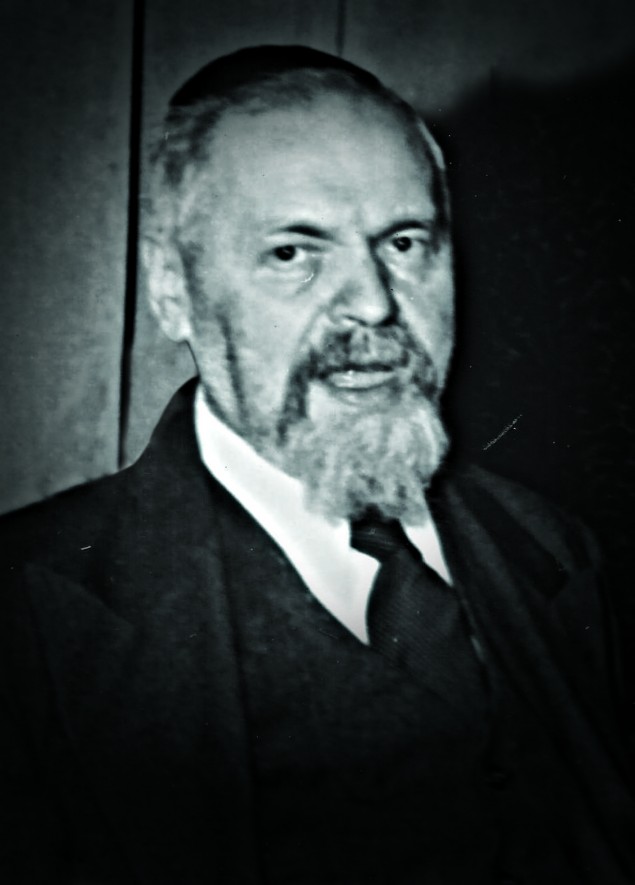RABBI MEIR BAR-ILAN: FORGOTTEN PIONEER OF JEWISH ACTIVISM
With the recent celebration of the 100th anniversary of the Mizrachi Religious Zionists of America, we highlight the life of Rabbi Meir Bar-Ilan, the founder of the movement.
By Rafael Medoff
In 1943, at a time when no organized Jewish lobby in Washington existed, Rabbi Meir Bar-Ilan undertook an extraordinary one-man lobbying mission to Capitol Hill in an attempt to save European Jewry.
His name is not found in most books about American Zionism. Nor will you find his name mentioned in most works about American Jewry’s response to the Holocaust.
Nevertheless, Rabbi Meir Bar-Ilan (Berlin), one of the founding fathers of the Religious Zionist movement, played a critical role in galvanizing US Jewry to respond to the slaughtering of Jews in the 1940s.
The youngest son of Rabbi Naftali Zvi Yehuda Berlin, the famed Netziv, Meir Bar-Ilan studied at his father’s yeshivah in Volozhin, Lithuania, earning rabbinical ordination at age twenty-two. While pursuing his university education in Germany, Rabbi Bar-Ilan joined Mizrachi, the fledgling Religious Zionist movement. He rose quickly in its ranks and served as a Mizrachi delegate to the Seventh Zionist Congress in 1905. By 1911, Rabbi Bar-Ilan was secretary of the Mizrachi movement and editor of its weekly publication, Ha-Ivri. Soon he was on his way to the United States to organize its American wing. The founding convention of the Mizrachi Religious Zionists of America was held in Cincinnati in May 1914.
By 1916, the American branch of Mizrachi boasted more than one hundred local chapters, a national office in New York City and, perhaps most important, the Mizrachi Teachers’ Institute. (Known as the Teachers’ Institute of Yeshiva University, TI trained the educators who instilled the values of Religious Zionism and Modern Orthodoxy in several generations of young American Jews.)
Rabbi Bar-Ilan settled in Jerusalem in 1923. In the years following, he rose to the presidency of the World Mizrachi Organization, founded the daily Religious Zionist newspaper Hatzofeh and initiated the Encyclopedia Talmudit, a Hebrew encyclopedia that summarizes halachic topics in the Talmud, thirty-three volumes of which have been published to date. He also served in the leadership of a number of Zionist bodies, including the Zionist Executive, the presidium of multiple Zionist Congresses and the Executive Committee of the Jewish National Fund.
Return to America
At the beginning of 1943, Rabbi Bar-Ilan returned to the United States, arriving after six arduous days of flights from Cairo, across North Africa, then Brazil and finally, to America.
Just a few weeks earlier, the Allies had confirmed that the mass murder of Europe’s Jews was underway. American Jewish leaders proclaimed a day of fasting and prayer, and memorial rallies were held in Jewish communities around the country. But by late December and early January, American Jews had largely lapsed into inactivity. “We have fasted, but is that all we can do for the Jews in Hitler-land as they walk in the Valley of Shadows?,” a columnist for the New York Yiddish daily Der Tog asked.
Rabbi Bar-Ilan answered with a resounding “no.”
In February 1943, he undertook a remarkable one-man lobbying mission to Capitol Hill. Rabbi Bar-Ilan managed to secure meetings with Vice President Henry Wallace, leading congressmen and foreign ambassadors to make the case for rescuing Jewish refugees and establishing a Jewish state. His unpublished report of his mission, which he circulated among other Jewish leaders, is a rich source of information about the mood on Capitol Hill as the Jewish tragedy was unfolding.
“If horses were being slaughtered as are the Jews of Poland, there would by now be a loud demand for organized action against such cruelty to animals. Somehow, when it concerns Jews, everybody remains silent, including the intellectuals and humanitarians of free and enlightened America.”
Rabbi Bar-Ilan’s three days in Washington began with a meeting with Senate Majority Leader Alben Barkley (D-Ky), who was to serve as vice president under Harry Truman. The rabbi quickly discovered that he had his work cut out for him.
Rabbi Bar-Ilan began by raising the question of what he called “the amazing and utter silence of the United States government in regard to the terrible situation of the Jews in Nazi-occupied lands,” pointing out that in England, by contrast, numerous members of Parliament had spoken out regarding the plight of the Jews. He cited a recent New York Times report that the Romanian government would permit the emigration of 70,000 Jews in exchange for the equivalent of $50 per person to cover transportation expenses. But Rabbi Bar-Ilan was disappointed to discover that Senator Barkley “had no knowledge at all of the above article.” Moreover, the senate majority leader was “quite unfamiliar with many essential facts and occurrences in Jewish life.”
Indeed, when Rabbi Bar-Ilan asked about “the possibility of the United States absorbing a number of refugees,” Senator Barkley responded that “with the present set-up in Congress there is no possibility of ‘opening the doors’ of this country.” Barkley’s claim that anti-immigration sentiment in Congress made it impossible to bring in more refugees was mistaken.
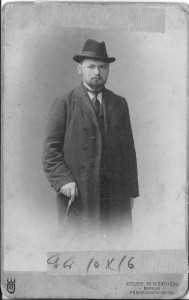
The youngest son of Rabbi Naftali Zvi Yehuda Berlin, the famed Netziv, Meir Bar-Ilan studied at his father’s yeshivah in Volozhin, Lithuania, earning rabbinical ordination at age twenty-two. This photo was taken circa 1900, when he was twenty years old.
Photo courtesy of Professor Meir Bar-Ilan, grandson of Rabbi Meir Bar-Ilan
The real problem was that the Roosevelt administration had created thick layers of bureaucratic obstacles to reduce immigration far below what the quota system allowed. During the previous year (1942), for example, the quota for immigrants from Germany and Austria was 82 percent unfilled, and the quota for Poland was 66 percent unfilled. Many lives could have been saved simply by permitting immigration up to the maximum allowed by law. Yet even the majority leader of the US Senate was unaware of these basic facts.
Rabbi Bar-Ilan concluded his meeting with Senator Barkley on a spiritual note: “The Jewish people is permeated by an ancient and historically confirmed belief that nations who subject it to torture and persecution sooner or later feel the full measure of God’s punishing wrath,” he told the senator. “At the same time, God Almighty sends his blessing to those peoples who stand by the Jews in their time of peril.”
If They Were Killing Horses
Next on Rabbi Bar-Ilan’s agenda was a meeting with Senator Robert Wagner (D-NY). “I again expressed my astonishment that nothing practical has so far been done to help the Jews in their great despair,” the rabbi later recalled. “If horses were being slaughtered as are the Jews of Poland, there would by now be a loud demand for organized action against such cruelty to animals. Somehow, when it concerns Jews, everybody remains silent, including the intellectuals and humanitarians of free and enlightened America.”
Two years later, in a sad fulfillment of Rabbi Bar-Ilan’s dire prediction, US General George Patton diverted US troops to rescue 150 prized Lipizzaner dancing horses which were caught between Allied and Axis forces along the German-Czech border.
Although he was a senator from the state with the single-largest concentration of Jewish voters, Wagner was remarkably “lukewarm” on matters of Jewish concern, Rabbi Bar-Ilan found. Wagner blamed Congress for blocking immigration, insisted he had “no influence” regarding the British closure of Palestine to Jewish refugees and tried to change the subject to the status of Jews in the Soviet Union, whom he claimed were “well situated.”
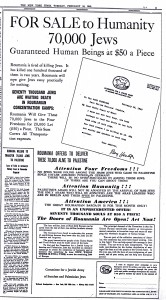
In the 1940s, Peter Bergson, a young Zionist, and his followers began using unorthodox methods to arouse the public to the atrocities in Europe. In response to a report that the Romanian government was prepared to ship 70,000 Jews to a safe haven as long as the Allies paid to cover the expenses, the Bergson group took out an ad with a shocking headline: “FOR SALE TO HUMANITY 70,000 JEWS, GUARANTEED HUMAN BEINGS AT $50 A PIECE.” The ad demanded that Allies respond to end the extermination of European Jewry. The established American Jewish leadership was horrified, and attacked the Bergson group. Even though it was controversial, Rabbi Meir Bar-Ilan publicly praised Bergson for his efforts to save European Jewry.
Courtesy of the David S. Wyman Institute for Holocaust Studies
A Second Cyrus?
Rabbi Bar-Ilan’s “most disappointing” meeting was with Vice President Henry Wallace. The rabbi began by pleading for US intervention to help create a Jewish state: “Jews are now hoping for the revelation of a second Cyrus, who . . . would be of even greater historic importance than his predecessor [since] according to our ancient mystic tradition, the third resurrection of Jewish nationhood is to be everlasting.”
A Jewish homeland was an urgent necessity, Rabbi Bar-Ilan explained, because the Jews were “threatened with total extinction.” But the vice president responded by “inject[ing] the curt remark, ‘I cannot agree with you on that.’” Wallace even refused to clearly endorse Zionism, citing the fact that many Jewish groups in America were totally against Zionism and he had no right to consider the opinion of one group in preference to another.
Although most American Jews were in favor of Zionism, the American Jewish Committee, some segments of the Reform rabbinate and the recently established American Council for Judaism were opposed to creating a Jewish state.
Rabbi Bar-Ilan tried a different tack: the United States, he pointed out, was acting as “the God-appointed liberator” of France from the Nazis, even though there were many pro-Nazi Frenchmen “who are diametrically opposed” to America’s war against Hitler. But the vice president did not budge.
Wallace’s own diary entry about the meeting was not especially pleasant. “Rabbi Bar-Ilan asked me pointblank for a message which he could take to the Jews in Palestine concerning what I would do for them after the war,” the vice president wrote. “I told him with equal frankness that I would not give them any such message . . . He was very much disappointed. I must confess that there are certain types of religious leaders who have a very poor sense of time and place.”
Later that day, Wallace mentioned his conversation with Rabbi Bar-Ilan to Congressman Sol Bloom, a Jewish Democrat from New York who strongly supported the Roosevelt administration’s position on Zionism and refugees. Bloom told Wallace, as recorded in the latter’s diary, that “the Zionists were troublemakers” and if there was any more trouble with fellows like Rabbi Bar-Ilan to send them over to him.
A Republican’s Perspective
Rabbi Bar-Ilan received a different response from the one Republican congressman with whom he met, House Minority Leader Joseph Martin of Massachusetts. “With tears in my eyes and uncontrolled emotions,” the rabbi described the plight of Jews in Hitler Europe. “The congressman was apparently touched by my words . . . . ‘That is surely wrong,’ [Martin] exclaimed,” when Rabbi Bar-Ilan described the British policy of keeping Jews out of Palestine. The congressman promised to “do whatever possible” to facilitate a congressional resolution about European Jewry, and would “try to do his very best” to press the British on Palestine.
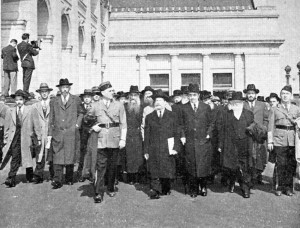
Many of Rabbi Bar-Ilan’s Mizrachi colleagues took part in the Rabbis’ March on Washington, D.C., on October 6, 1943, a demonstration to stop the destruction of European Jewry. Photo courtesy of the David S. Wyman Institute for Holocaust Studies
The problem, Rabbi Bar-Ilan later wrote, was that “Congressman Martin has, until now, not been approached at all about Zionism or general Jewish matters and it is truly a pity that we are neglecting people of this caliber . . . These men must be furnished with proper material which will bring home to them some knowledge of our situation.”
Although Rabbi Bar-Ilan did not quite spell it out, the American Jewish leadership’s failure to build ties to the House Minority Leader was motivated largely by political considerations. Most Jewish leaders strongly supported President Franklin Roosevelt, the New Deal and the Democratic Party, and confined their Capitol Hill contacts to those with whom they had the most in common. Today, of course, Jewish activists carefully cultivate relationships on both sides of the aisle. But in the 1940s, Jewish lobbying was far less sophisticated, as Rabbi Bar-Ilan discovered to his sorrow.
Galvanizing the Establishment
During the spring and summer of 1943, Rabbi Bar-Ilan assumed a different role: gadfly to the Jewish establishment. As a representative of Mizrachi, he took part in a number of meetings of two major Jewish coalition groups, the Joint Emergency Committee for European Jewish Affairs and the Emergency Committee for Zionist Affairs. There he repeatedly pressed for greater activism by the Jewish leadership.
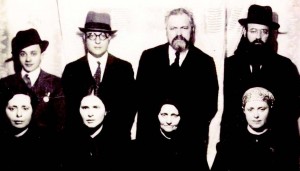
Rabbi bar-Ilan is standing second from the right. His mother, Batya Miriam, the daughter of Rabbi Yechiel HaLevi Epstein, is sitting below. Photo courtesy of Professor Meir Bar-Ilan
The transcript of one meeting, for example, records: “Rabbi Bar-Ilan complained bitterly about the indifference, inadequate action and lack of feeling [regarding European Jewry] on the part of American Jews compared with the Palestine Jews.” The Jews of the yishuv “engage in street demonstrations, sign huge petitions [and] close shops,” he said. “They are discouraged by the silence of the American Jews.” The rabbi proposed a general shutdown of Jewish-owned stores “for a day or half a day, or an hour or half an hour, including such shops as Macy’s, Saks and others, to show to the Jews as well as to non-Jews their sympathy for the Jewish victims of Nazi barbarism . . .”
At another meeting of the Joint Emergency Committee for European Jewish Affairs, he pressed for a concerted public campaign against the White Paper. He pointed out—perhaps having in mind his experiences in Washington—that many people in political life in America were ignorant of the significance of the White Paper and that plans should be made to provide the necessary information. He also urged that the issue “be brought to the attention of the President.”
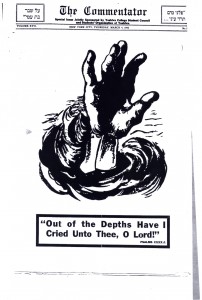
During his stay in the United States, Rabbi Bar- Ilan tried to inspire American Jews to push for the rescue of Jews in Nazi Europe. The March 4, 1943 issue of the Yeshiva University student newspaper The Commentator was devoted to the plight of Europe’s Jews. Courtesy of the David S. Wyman Institute for Holocaust Studies
A Threat to “Zionist Discipline”
The rabbi unexpectedly found himself on the defensive after Mizrachi decided to open its own lobbying office in Washington, D.C., in May 1943. Rabbi Bar-Ilan explained to Rabbi Stephen S. Wise, the leading Reform and Zionist leader in America, that prior to his recent arrival in the US, he was “under the impression that there is in this country an effective and constant political bureau in Washington which is devoting itself to political Zionist influence exclusively and uninterruptedly . . . I was amazed to find, however, that there is no such bureau or institute in existence.” Thus a Mizrachi office in the capital would pose no competition to the existing Jewish groups but would simply help fill the void, he contended.
Wise and his colleagues vehemently disagreed. At a meeting of the Emergency Committee for Zionist Affairs, they adopted a resolution condemning Mizrachi for “threatening the entire disciplinary structure of the World Zionist Organization” by acting “without any authorization” from the Zionist movement. The resolution demanded that Mizrachi “discontinue [its] office.” After further debate, the participants accepted a compromise: Mizrachi would “suspend its activities in Washington for the next few weeks to give the Emergency Committee an opportunity to open a Washington office” of its own.
In principle, Rabbi Bar-Ilan had scored a significant victory: his plan had forced the establishment to do something it otherwise may not have done. In the end, it took six months, rather than “a few weeks,” but the office that the Emergency Committee finally opened that autumn did important work in educating Congress and the administration about the need for a Jewish state.
Awakening Consciences
In early 1944, Rabbi Bar-Ilan returned to Eretz Yisrael (which is when he Hebraicized his name). Not surprisingly, he harbored bitter feelings about some of his experiences in the United States. At a press conference in Jerusalem in June of that year, he spoke warmly of the dissident Bergson Group for organizing rallies for rescue, mobilizing 400 rabbis to march to the White House and placing ads in US newspapers about the plight of European Jewry. While the Bergsonites had done much to “awaken the conscience of the American people,” Jewish establishment groups had worked to “undermine the prestige” of the activists, the rabbi charged.
Although Rabbi Bar-Ilan reserved his praise for the Bergson Group and said nothing about his own activities in the United States, the fact is that he too, in his own way, helped raise awareness of Jewish suffering and galvanized American Jewish leaders.
While Rabbi Bar-Ilan was taken from this world too soon at age sixty-nine, his legacy lives on in the university that bears his name, and in the model of humanitarianism and civic engagement that he provided for future generations of Orthodox Jewish activists to emulate.
Dr. Rafael Medoff is founding director of the David S. Wyman Institute for Holocaust Studies in Washington, D.C., and author of fourteen books about Jewish history, Zionism and the Holocaust, including the Historical Dictionary of Zionism (with Chaim I. Waxman [2008]).

